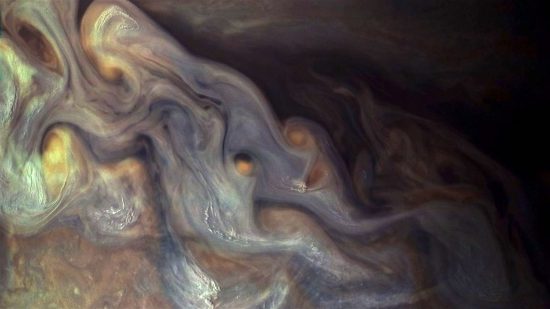Nov 17, 2017
Jupiter’s environment Is electrically active.
The Juno spacecraft entered orbit around Jupiter in July 2016 and began collecting data on its atmosphere, as well as its electromagnetic and gravitational fields. Jupiter’s toroidal electromagnetic field is so large that it extends outward beyond Saturn’s orbit. Charged particles from the solar wind, as well as ions from Jupiter, are captured by its magnetic field, creating plasma bands similar to the Van Allen belts around Earth. Those around Jupiter emit lethal radiation, however, thousands of times stronger than the Van Allen belts.
Galileo discovered electric charge flowing around the planet, just as Electric Universe advocates predicted. As Jupiter’s moon Io revolves, more than 2 trillion watts of power is dissipated between them. The electricity travels in Jupiter’s magnetic field, creating lightning in the planet’s upper atmosphere, as well as intense aurorae at the poles.
There are thin rings surrounding Jupiter, formed from a thin sheet of material encircling the planet. The ring structure is quite diffuse, making observations difficult unless they are in correct alignment with the Sun. The outer radius begins at 129,000 kilometers, almost the same distance as the moon Adrastea.
The four small moons, Metis, Adrastea, Amalthea and Thebe, are said to influence the structure of Jupiter’s rings in the same way that the “shepherd moons” of Saturn govern the shape of its rings. However, as previous Picture of the Day articles about Saturn point out, there is evidence to suggest that electricity is a primary factor in the structure of any ring system.
An electrical interaction between Jupiter and its moons means that they are charged bodies and are not electrically neutral. Some research papers attribute the auroral flares to “…pulsed reconnections of the magnetic field at the planet’s dayside magnetopause…”
The light bursts from Jupiter’s aurorae are said to be the result of “magnetic reconnection” events. The solar wind is said to “stretch” its magnetic field like a rubber band. When it “snaps back” the over-stretched magnetic field lines explode, converting some of the “magnetic energy” to heat and light. As was discussed in a previous Picture of the Day, how that energy is released is not known. It seems, though, that space scientists are reversing cause (electric currents) and effect (magnetic fields). They downplay or deny the importance of electrical processes.
Retired Professor of Electrical Engineering Donald Scott’s admonitions about magnetic reconnection should be kept in mind:
- Magnetic field lines are only convenient concepts, nothing more. They are not loci or contours of constant magnetic flux density (field strength). They just indicate the field’s direction. In regions where they are close together the field is stronger than where they are widely separated.
- Therefore, sketching magnetic field lines can help us visualize the shape and strength of magnetic fields. They can help us to sketch the net result (vector sum) if and when two or more fields interact (are superimposed on each other).
- We can only draw magnetic field lines (in cases not involving permanent ferromagnetic magnets) by considering the electric currents that create those fields.
- Magnetic lines of force do not actually exist in three-dimensional space anymore than lines of latitude or longitude do.
- If a field changes from one instant to another, we cannot use “streaming video” to watch a given line move and change shape. This is because we must redraw a complete set of lines at each instant. It isn’t the same line that has moved it is the field that has changed. The two sets of lines describe the field at those two different times.
- Magnetic lines of force do not move any more than lines of longitude do. A determined unwillingness to recognize this fact has led to the idea that lines can move toward each other, touch, merge, and then release energy. This last notion, if applied to circles of longitude that come together and “merge” at Earth’s poles, could be proposed as causing gravitational energy releases at those locations.
There is no such process as “magnetic merging” or “reconnection” of magnetic field lines in the real world.
Stephen Smith













